Matthew Shaw shares the tunnels, tombs, standing stones and seals documented in his notebooks on a recent trip to the Isles of Scilly.
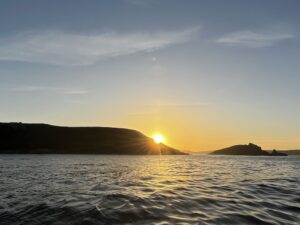
Tuesday 6th September
Diary entry:
The Scillonian III pulls away from the quayside in Penzance and heads out along the Cornish coast. I stand up on the top deck and watch as we pass Newlyn, Mousehole, Lamorna Cove and the Minack Theatre until, after running parallel with Land’s End, the boat moves away from the coast and out into the Atlantic.
I’ve dreamt of visiting the Scilly Isles for years, fascinated with the passage tombs and burial chambers and standing stones that are spread across the islands. Craig Weatherill’s Cornovia book is full of sites that I’ve read about and longed to visit and now, finally, after years of waiting, today is the day.
Our first stop is the Island of Tresco. We meet our friends who are kindly hosting us for a few days and head straight out to St Nicholas’s Priory at Tresco Abbey Gardens, a beautiful sub-tropical garden. The garden is fecund, alive with colour, vibrant and enveloping. Our destination is the holed stone. Before we set off I looked up the stone and the folklore surrounding it:
‘In the old abbey gardens at Tresco is a curious stone, about four feet long, two feet wide, and six inches in thickness, in an upright position. Near the top are two holes, one above the other (one being somewhat larger than the other), through which a man might pass his hand. It is supposed to be an old Druidical betrothal or wishing-stone, and used before the monks built the abbey at Tresco. Young people, engaged to be married, would pass their hands through the holes, and, joining them together, would so plight their troth. As a wishing-stone, or to break a spell, a ring would be passed through the holes with some incantations.’ – J.C. Tonkin’s Guide to the Isles of Scilly.
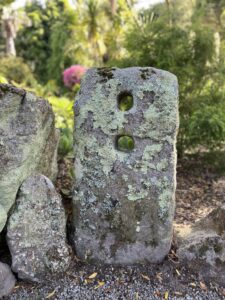
Perhaps it is the romance of the story or perhaps the excitement of the moment but our friends instinctively put their hands through in the ancient act of hand fasting, a commitment of a year and a day. This stone has seen many such occasions I’m sure, and today it feels like a good omen but only time will tell!
Later in the evening we head out in a small boat to the Eastern Isles. The sun is a deep golden colour, melting into the sea. As we approach a small beach we see what looks to be a perfect line of large stones — as we get closer we realise these are not stones at all but seals basking in the evening sun. At a rough count there must be 150 or so seals here. We shut off the boat’s engine a safe distance back and listen to their songs and conversations as they watch us. Some take to the water and swim over to check us out, their heads appearing momentarily before diving back beneath the water’s surface to appear elsewhere moments later.
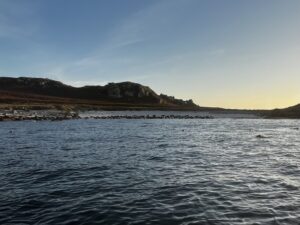
Wednesday 7th September
Fieldnotes, Castle Down Entrance Grave:
I am sat on the capstone of Castle Down entrance grave. I’ve spent an hour or so trying to locate the entrance grave on this hill covered in heather, gorse and stone. It’s almost impossible at first to see any pattern to this place. Apparently there are 78 cairns here on the downs as well as round houses and ancient walls and field systems, a patchwork of ancient habitation, of placed stones and footsteps. It takes a while for one’s eye to adjust to what’s what. At least it did for me! After much searching I manage to compose myself enough to stop rushing about with excitement and instead to properly consult the OS map, a wise decision as I am soon rewarded with finding the desired chambered tomb. The view sitting here is breathtaking, the curve of the coast to the headland and the islands beyond, like looking out to the lost land of Lyonnesse, rediscovered in this very moment.
I look up a quote I read on the boat over here from Rambles in Western Cornwall by J O Halliwell-Phillipps published in 1861:
‘Under the cliffs of Pennines Head on St Mary’s there is a cavern, termed the Piper’s Hole, which extends a long distance under ground, and is absurdly said to communicate with another cave of the same title, the entrance to which is in the island of Tresco. This legend would make the length of the cavern at least four miles; and the inhabitants of the locality tell you of dogs let in at the one entrance coming out, after a time, at the other with most of their hair off, so narrow are some parts of the cave. So there is a tradition in Scotland of a man getting through a similar cave, but paying the penalty in the loss of all his skin.’
It’s easy to imagine these tunnels and the possibilities in this strange and magical late afternoon light, where passage tombs hide in the heather and the land itself seems to speak.
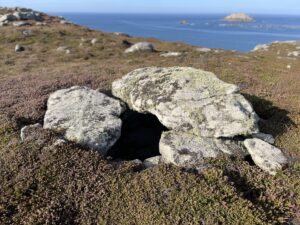
Wednesday 8th September
Diary:
This morning our friends offer to drive us across to St. Mary’s so that we can explore the entrance graves on the island. We travel over with Philip McMillan Browse as a fellow passenger. I talk with Phillip about how he grew up on the Scillies and how this trip is to return one final time as Philip is now at an age where this could be his last visit. This is a conversation of deep joy and happy memories rather than of sombre nostalgia. Philip’s memories of a post-war childhood, of the freedom of exploring and being so close to nature are poignant and tell of a world long vanished. Philip went on to become a professional horticulturist, and, passionate about plant propagation, he helped to discover the Lost Gardens of Heligan and grew plants for the Eden Project. There will be the legacy of Philip’s green fingers in Cornwall for many generations to come.
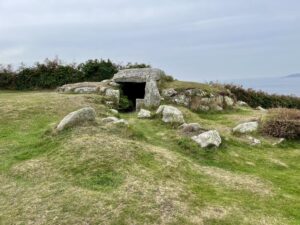
Fieldnotes, Halangy Down & Bant’s Carn:
I am sat within an ancient home at the ancient village of Halangy Down. This is a large settlement with many dwellings and stunning coastal views. To my right is an enormous modern telecommunications mast, to my left is Bant’s Carn, a Neolithic or early Bronze Age entrance grave. I’m reminded of being at Carn Euny ancient village in West Penwith in Cornwall, with its Fogou and hut circles. I’m always drawn to the mystery of the Fogou, its purpose still much disputed and ultimately unknown. Bant’s Carn’s purpose is much clearer; this was a tomb, a place of death but also a place of light, with the passage and alignments always pointing to a new dawn and cyclical thinking rather than a linear end.
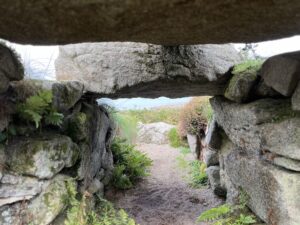
Fieldnotes, Innisidgen Bronze Age chambered tombs:
A short walk along the coast brings us to Lower Innisidgen, another passage tomb, smaller than Bant’s Carn and more mysterious somehow too. The entrance is opposite the coast with a portal to the islands opposite. I wonder how this would have looked and been used by the people that created this Carn. Its position feels liminal, between land and water, life and death, and as the light falls, between day and night. I’m now on a rocky outcrop looking down on Higher Innisidgen, the most grand of all of the sites we’ve visited so far. Teän Roberts, an artist and Scilly Island native, has joined us for this afternoon and is the best guide to these sites, having known them all her life. There are stories almost as ancient as the places themselves and the living memory of childhood games played, teenage hours whiled away and ultimately the acknowledgement and reconciliation of home. To see the island through Teän’s eyes is a beautiful thing, added to the excitement of finally being here on these magical islands for the first time, for a few days of deep time travel.
Matthew Shaw is an artist, and co-founder of Stone Club.